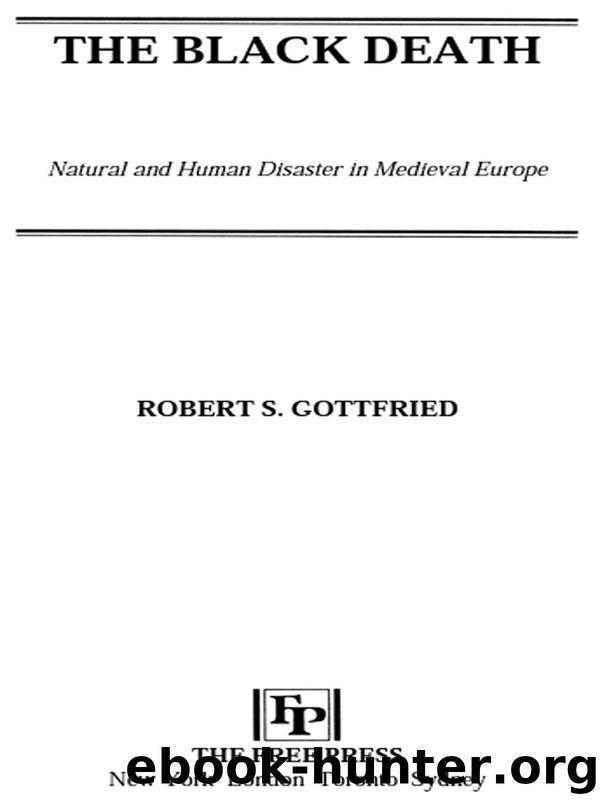Black Death by Gottfried Robert S

Author:Gottfried, Robert S. [Gottfried, Robert S.]
Language: eng
Format: epub
Publisher: Free Press
Published: 2010-05-08T00:00:00+00:00
CHAPTER 6
The Stirrings of
Modern Medicine
ONE OF THE MOST important legacies of the Black Death was the destruction of the existing medical system and the beginning of its modern successor.1 In 1347, the members of Europe’s medical community were rigid and generally inept. Medical practice was based primarily on the ideas of Hippocrates, Galen, and several Arabic commentators, especially the Persian Avicenna. All these physicians had written about infectious disease, but none had had firsthand experience with plague. Structurally, the medical community was composed of five distinct divisions: physicians, surgeons, barber-surgeons, apothecaries, and unlicensed or nonprofessional practitioners. These divisions were inspired to some degree by the Greek system, but were intensified and rigidified by medieval thinkers. The system worked well enough during the High Middle Ages, an epoch devoid of most of the great deadly epidemics, but proved inadequate in dealing with plague and the other newly recognized infections of the fourteenth and fifteenth centuries. The response of doctors to the new medical problems resulted in a series of changes that led to the evolution of modern clinical medicine in the seventeenth century.
In order to understand the first stages in this evolution it is necessary to look at the old system.2 The structural division of medical professionals fitted well with the medieval conception of trifunctionalism. At the top were physicians. They were the elite, highly trained in current theories of medicine, small in number, and very exclusive; they were accorded a degree of respect and prestige in keeping with their role as the paramount authorities. They were the heirs to Hippocrates and Galen. Physicians were always men and, in northern Europe, usually members of the clergy. This religious connection was important, part of an association of medicine and religion extending to the Biblical world and, no doubt, beyond, in which the power to heal was associated with first magic, then the supernatural, and finally, special religious gifts. As a result, medieval medical education was generally connected with and supervised by the church. It was this university-based education more than anything else that distinguished physicians from other medical professionals.3 By the fourteenth century, a student interested in medicine would have started his education in a grammar school at about age 9, concentrating on the Seven Liberal Arts—grammar, rhetoric, dialectic, arithmetic, geometry, music, and astronomy. If he could raise the money—higher education then, as now, was expensive—the promising scholar would enter a university between age 15 and 18 and spend another 4 to 7 years studying the Liberal Arts, usually specializing in one of the seven. Upon completing his studies and passing a series of examinations, he would earn a baccalaureate degree. It was at this point that his formal medical education began.
Most of the medical corpus was of classical origin or inspiration, but the format in which it was studied was medieval, modeled after the scholastic method popularized around 1100 by Peter Abelard, a teacher at the cathedral schools in Paris.4 In his Sic et Non, Abelard emphasized the pedagogical importance of dialectic.
Download
This site does not store any files on its server. We only index and link to content provided by other sites. Please contact the content providers to delete copyright contents if any and email us, we'll remove relevant links or contents immediately.
| Africa | Americas |
| Arctic & Antarctica | Asia |
| Australia & Oceania | Europe |
| Middle East | Russia |
| United States | World |
| Ancient Civilizations | Military |
| Historical Study & Educational Resources |
Room 212 by Kate Stewart(5070)
The Crown by Robert Lacey(4761)
Endurance: Shackleton's Incredible Voyage by Alfred Lansing(4719)
The Iron Duke by The Iron Duke(4319)
The Rape of Nanking by Iris Chang(4165)
Joan of Arc by Mary Gordon(4053)
Killing England by Bill O'Reilly(3968)
Say Nothing by Patrick Radden Keefe(3937)
I'll Give You the Sun by Jandy Nelson(3394)
Shadow of Night by Deborah Harkness(3325)
Hitler's Monsters by Eric Kurlander(3291)
Mary, Queen of Scots, and the Murder of Lord Darnley by Alison Weir(3171)
Blood and Sand by Alex Von Tunzelmann(3164)
Eleanor & Park by Rainbow Rowell(3110)
Darkest Hour by Anthony McCarten(3096)
Margaret Thatcher: The Autobiography by Thatcher Margaret(3046)
Book of Life by Deborah Harkness(2892)
Red Famine: Stalin's War on Ukraine by Anne Applebaum(2890)
The One Memory of Flora Banks by Emily Barr(2829)
